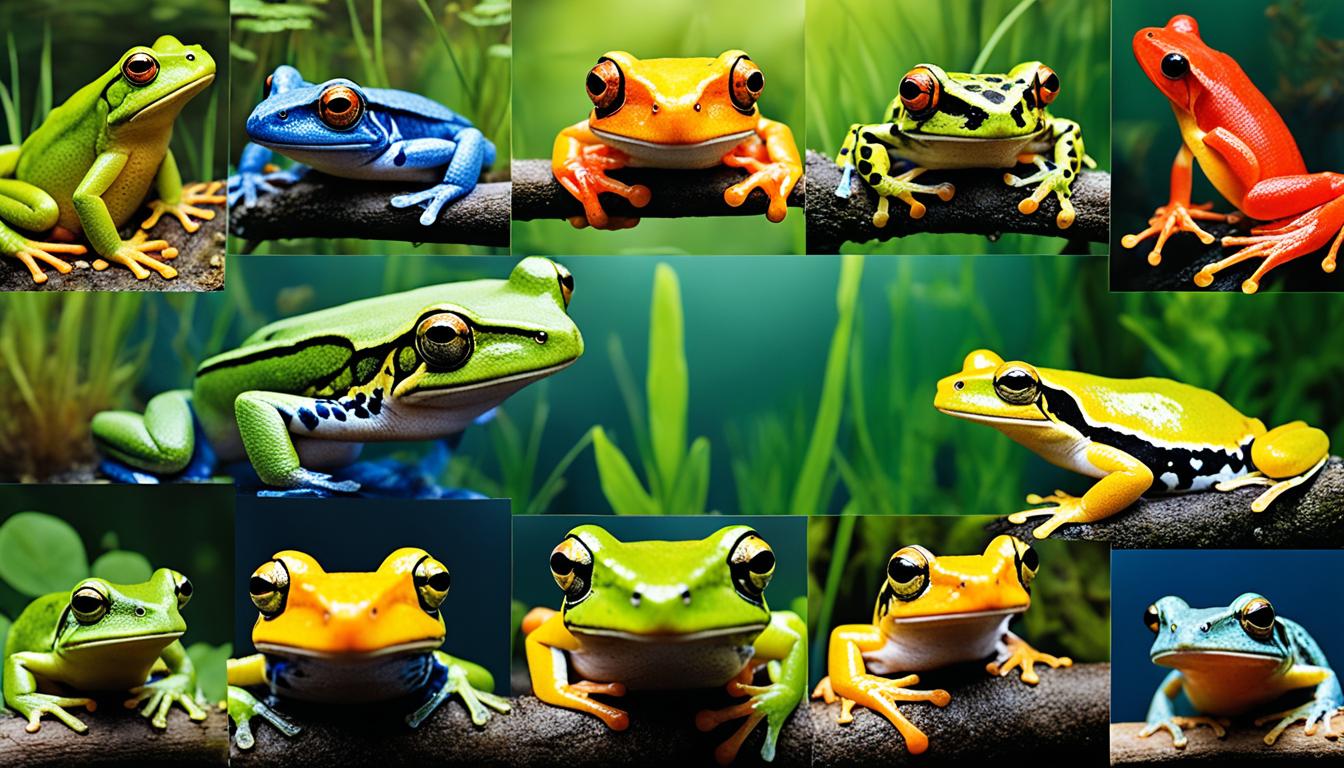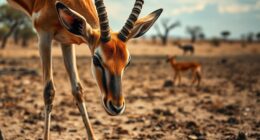Did you realize that amphibians have survived on Earth for more than 360 million years? These captivating creatures have endured through time, adjusting to various environments and evolving unique traits that distinguish them from other animals. From their ability to live in both land and water to their remarkable metamorphosis, amphibians are indeed experts in adaptation.
In this article, we will take a deep dive into the enchanting world of amphibians, exploring their extraordinary abilities and the challenges they face in conserving their existence. Join us as we unravel the secrets of their dual lifestyles, delve into their life cycles, and discover the incredible diversity that exists among these remarkable creatures.
Key Takeaways:
- Amphibians have been thriving on Earth for over 360 million years.
- They have adapted to diverse environments and developed unique characteristics.
- Amphibians lead dual lives on land and in water.
- They undergo a remarkable metamorphosis during their life cycle.
- Conservation efforts are crucial to protect these extraordinary creatures.
Understanding Amphibians
In this section, we will delve deeper into understanding amphibians. These fascinating creatures have captured the curiosity of scientists and nature enthusiasts alike with their unique biology, behavior, and habitat preferences. By exploring the intricacies of their biology and their crucial role in various ecosystems, we can gain a deeper appreciation for amphibians and their fascinating world.
Amphibians have a diverse range of physical characteristics and adaptations that allow them to thrive in different environments. From their dual lives on land and in water to their cold-blooded nature and moist, permeable skin, each feature contributes to their biology and ability to survive. These remarkable creatures have primitive lungs and can also breathe through their skin, a process known as cutaneous respiration.
These amphibians play an important ecological role as well. They occupy various habitats, including wetlands, rainforests, and even urban environments. Their behavior, such as their foraging strategies and breeding rituals, contributes to the balance and stability of ecosystems. By understanding their habitat preferences and behavior, we can ensure their conservation and protect their delicate ecosystems.
Amphibians are not just fascinating creatures; they are an integral part of our ecosystems. Their unique biology and behavior contribute to the delicate balance of nature. It is essential that we continue to deepen our understanding of these remarkable creatures to safeguard their future and the health of our planet.
By the end of this section, readers will have a solid foundation of knowledge about amphibians’ biology, behavior, and habitat preferences. This understanding will serve as a basis for exploring the characteristics, life cycle, conservation challenges, and the role of amphibians in ecosystems in the following sections.
Characteristics Of Amphibians
Amphibians are fascinating creatures with unique characteristics that set them apart from other animals. In this section, we will explore the different traits that make amphibians so special.
Dual Lives: Land and Water
One of the most remarkable aspects of amphibians is their ability to live both on land and in water. They have adapted to thrive in diverse habitats, such as rivers, lakes, ponds, and forests. This dual lifestyle allows them to take advantage of the resources and opportunities available in both environments.
Cold-blooded (Ectothermic)
Amphibians are cold-blooded animals, which means their body temperature is not regulated internally. Instead, their temperature is dependent on the environment. This allows amphibians to conserve energy and adapt to different temperature conditions.
Moist, Permeable Skin
Amphibians have moist and permeable skin that plays a crucial role in their survival. Their skin helps them breathe, absorb water, and regulate body fluids. It also protects them from dehydration and serves as a defense against predators.
Primitive Lungs and Cutaneous Respiration
While amphibians have lungs, their respiratory system is not as efficient as that of mammals. They primarily rely on cutaneous respiration, which is the exchange of oxygen and carbon dioxide through their skin. This allows them to absorb oxygen from both air and water.
Three-Chambered Heart
Amphibians have a three-chambered heart, which consists of two atria and one ventricle. This unique heart structure allows for partial separation of oxygenated and deoxygenated blood, enabling amphibians to meet their metabolic needs.
Reliance on Water for Reproduction
Reproduction in amphibians typically requires water. Many species lay eggs in water, where fertilization takes place externally. The aquatic environment provides a suitable habitat for eggs to develop and hatch into tadpoles or larvae.
Metamorphosis
One of the most fascinating aspects of amphibians is their process of metamorphosis. Many amphibians undergo a remarkable transformation from aquatic larvae (tadpoles) to terrestrial adults. During metamorphosis, their bodies undergo structural and physiological changes that enable them to live on land.
Fertilizing Eggs Externally
Amphibians practice external fertilization, where the male releases sperm onto the eggs after the female lays them. This adaptation ensures that the eggs are fertilized in a watery environment, increasing the chances of successful reproduction.
Grow 4 Legs As An Adult
Amphibians start their lives as aquatic larvae with no limbs. However, as they undergo metamorphosis and transition into adulthood, they develop four legs, allowing them to move more efficiently on land.
Carnivorous Appetite
Amphibians have a carnivorous diet, feeding on a variety of invertebrates and small vertebrates. Their diet primarily consists of insects, worms, spiders, and small fish. This carnivorous appetite plays a crucial role in maintaining ecosystem balance.
Vertebrates
Amphibians are vertebrates, meaning they have a backbone or a spinal column. They belong to the same group as fish, reptiles, birds, and mammals. This classification places them among the most diverse and complex animals on Earth.

Life Cycle Of Amphibians
In this section, we will explore the life cycle of amphibians. Amphibians undergo a remarkable transformation as they progress through different stages of their life cycle. These stages include the egg stage, larval stage, metamorphosis, juvenile stage, and adult stage.
Egg Stage
The life cycle of amphibians begins with the egg stage. Amphibians are oviparous, meaning they lay eggs. These eggs are deposited in water, as most amphibians require a watery environment for reproduction. The eggs are typically gelatinous and protected by a jelly-like coating. They provide a safe environment for the developing embryo, shielding it from external threats.
Larval Stage
From the eggs hatch larvae that are commonly known as tadpoles. Tadpoles are fully aquatic and have specialized adaptations for living underwater. During this stage, tadpoles have gills for breathing and a long tail for swimming. They feed on algae, plants, and microorganisms present in the water. Tadpoles undergo significant growth and development during the larval stage.
Metamorphosis
Metamorphosis is a key phase in the life cycle of amphibians. During this process, tadpoles undergo dramatic changes in their body structure and physiology to transition from aquatic larvae to terrestrial adults. Metamorphosis involves the growth of limbs, loss of the tail, development of lungs for breathing air, and changes in skin texture and coloration.
Juvenile Stage
After completing metamorphosis, the tadpoles have transformed into juvenile amphibians. At this stage, they have acquired the necessary adaptations to survive on land. They have fully developed limbs for walking and hopping, lungs for breathing air, and a modified digestive system to accommodate their change in diet.
Adult Stage
The final stage in the life cycle of amphibians is the adult stage. Adult amphibians are sexually mature and capable of reproduction. They have completed their transition from a fully aquatic lifestyle to a terrestrial or semi-aquatic existence, depending on the species. Adult amphibians play a vital role in maintaining ecosystems, contributing to nutrient cycling and controlling populations of insects and other small organisms.
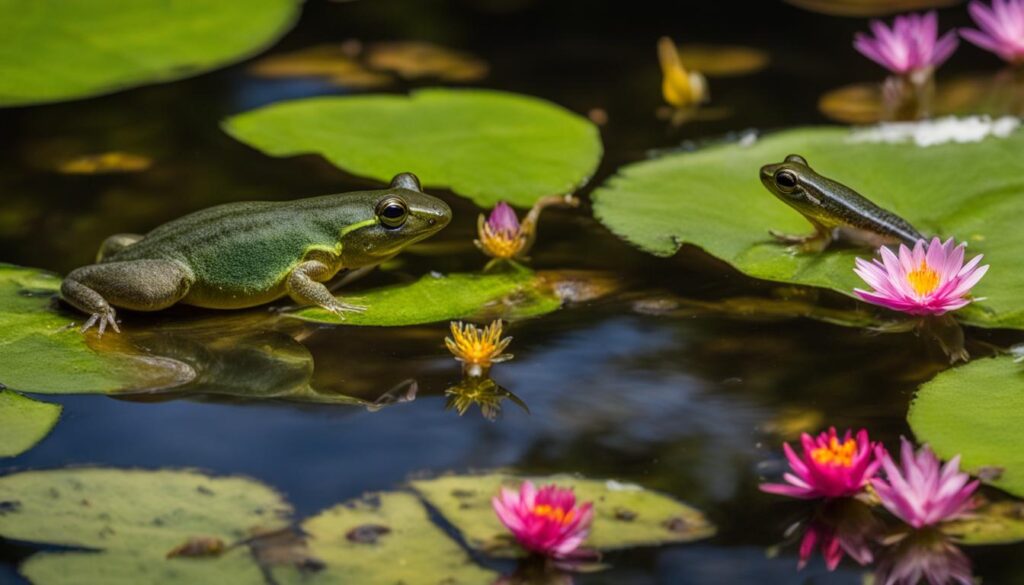
3 Different Types Of Amphibians
In this section, we will explore the three main types of amphibians: Anura, Apoda, and Urodela. Each type of amphibian has unique characteristics that set them apart from one another. Let’s take a closer look at each type and discover their fascinating world.
Anura: The Leaping Amphibians
Anura, also known as the leaping amphibians, includes frogs and toads. These amphibians are well-known for their exceptional jumping ability. Frogs and toads have powerful hind legs that allow them to leap long distances.
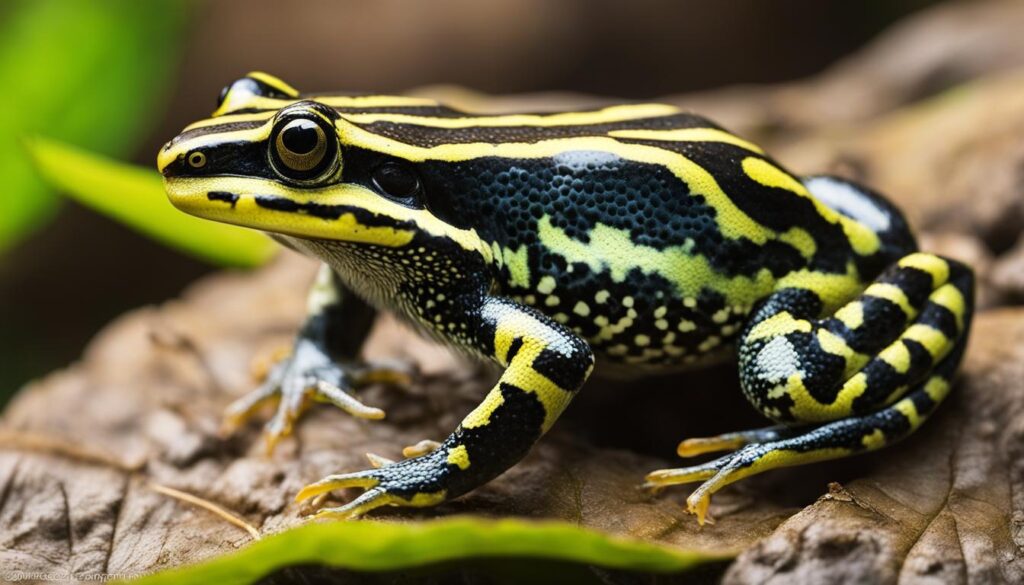
Apoda: The Legless Wonders
Apoda, also known as the legless wonders, are amphibians that lack limbs. Caecilians are the primary example of Apoda. These fascinating creatures have adapted to their underground habitats and have elongated bodies that facilitate burrowing.
Urodela: The Tailed Amphibians
Urodela, also known as the tailed amphibians, include salamanders and newts. These amphibians are characterized by their long tails, which play a vital role in their locomotion and balance. Salamanders and newts have the ability to regenerate lost limbs, making them a unique group among amphibians.
By exploring the different types of amphibians, Anura, Apoda, and Urodela, we gain a deeper understanding of the diverse and captivating world of amphibians. Each type has its own distinct features and adaptations that contribute to their survival and success in various ecosystems.
Threats And Conservation Of Amphibians
In this section, we will discuss the threats that amphibians face and the importance of conservation efforts. Amphibians, like many other species, are currently facing numerous challenges that jeopardize their survival. It is crucial to understand these threats and take action to protect these remarkable creatures.
Habitat Loss
One of the primary threats to amphibians is habitat loss. As human populations expand and urbanization increases, natural habitats are being destroyed or degraded. Wetlands, forests, and other critical habitats that amphibians rely on for survival are being cleared for agriculture, infrastructure development, and other purposes. The loss of suitable habitats disrupts their life cycles and diminishes their chances of finding food, mates, and suitable breeding grounds.
Climate Change
Climate change is another significant threat to amphibians. As temperatures rise and weather patterns become more erratic, amphibians are facing challenges in adapting to these changes. Increased temperatures can disrupt their metabolic activities, affect their breeding patterns, and alter their habitats. Climate change also contributes to the spread of diseases and pathogens that can decimate amphibian populations.
Pollution And Contamination
Pollution and contamination of water bodies and terrestrial environments pose a severe threat to amphibians. Chemical pollutants, such as pesticides, herbicides, fertilizers, and industrial waste, can accumulate in their habitats and have detrimental effects on their health and reproductive capabilities. Polluted water bodies can also harm amphibians directly by affecting their skin, which is vital for respiration and maintaining proper hydration.
Disease And Pathogens
Amphibians are susceptible to various diseases and pathogens, which pose a significant threat to their populations. The spread of chytrid fungus, for example, has led to severe declines in amphibian populations worldwide. Additionally, the introduction of non-native species, such as predatory fishes or other amphibian species, can introduce new diseases that native amphibians are not equipped to handle. These diseases and pathogens can cause mass mortality and disrupt the delicate balance of ecosystems.

These threats collectively contribute to the decline in amphibian populations globally. To mitigate these challenges and protect amphibians, conservation efforts are crucial. Conservation initiatives focus on preserving and restoring habitats, implementing sustainable land-use practices, reducing pollution, raising awareness, and conducting research on amphibian species and their ecological needs.
By understanding and addressing the threats faced by amphibians, we can work towards ensuring a future where these remarkable creatures can thrive and continue to play their vital roles in ecosystems around the world.
Conservation Efforts For Amphibians
In order to protect and preserve amphibians, various conservation organizations and initiatives have been established. These efforts play a crucial role in raising awareness, conducting research, and implementing strategies to ensure the survival of amphibian species.
Amphibian Survival Alliance (ASA)
The Amphibian Survival Alliance (ASA) is a global partnership working towards the conservation of amphibians. Comprising of over 100 organizations, the ASA aims to address the threats amphibians face, promote habitat protection, and support scientific research and education. Through collaboration, the ASA seeks to increase the effectiveness of conservation efforts and secure a future for amphibians worldwide.
Amphibian Ark (AArk)
The Amphibian Ark (AArk) is dedicated to the protection of the most threatened amphibian species through ex-situ conservation. AArk facilitates the establishment and management of assurance colonies, which are safe and sustainable populations of endangered amphibians maintained in captivity. The primary goal of AArk is to prevent the extinction of select amphibian species by safeguarding them in accredited institutions around the world.
Global Amphibian BioBlitz
The Global Amphibian BioBlitz is a citizen science initiative that encourages public participation in amphibian monitoring and conservation efforts. During BioBlitz events, individuals and communities are invited to document and record amphibian species within a specific region over a designated time period. By collecting data on amphibian populations and distributions, the Global Amphibian BioBlitz aims to enhance our understanding of amphibian habitats and contribute to their conservation.

| Organization | Focus |
|---|---|
| Amphibian Survival Alliance (ASA) | Addressing threats, habitat protection, research, and education |
| Amphibian Ark (AArk) | Ex-situ conservation of the most threatened amphibian species |
| Global Amphibian BioBlitz | Citizen science initiative for monitoring and documenting amphibians |
How Do Amphibians Adapt to Their Environment?
In order to survive and thrive in various habitats, amphibians have developed unique adaptations that allow them to adapt to their surroundings. Let’s explore some of these fascinating adaptations:
Habitats of Different Amphibian Species
Amphibians inhabit a wide range of environments, including freshwater, terrestrial, and arboreal habitats. These diverse habitats offer different challenges and opportunities for amphibians to thrive. For example, frogs and toads are commonly found in freshwater environments, where they rely on ponds, lakes, and streams for reproduction. On the other hand, salamanders and newts prefer moist terrestrial habitats, such as forests and wetlands. Some amphibians, like tree frogs, have adapted to arboreal habitats, where their specialized toe pads allow them to cling to trees and vegetation.
Adaptations for Moist Environments
One of the key adaptations of amphibians is their ability to thrive in moist environments. Their skin is highly permeable, allowing them to absorb water directly through their skin. This adaptation helps them stay hydrated and maintain the necessary moisture levels for their survival. Additionally, the skin of amphibians secretes mucus, which helps in maintaining skin moisture and provides protection against pathogens and parasites.
Metamorphosis Process in Amphibians
Amphibians undergo a remarkable metamorphosis process as part of their life cycle. This process allows them to transition from aquatic larvae, such as tadpoles, to terrestrial adults. During metamorphosis, they develop lungs, limbs, and other structures that enable them to survive on land. This adaptation is crucial for their survival as it allows them to exploit a wider range of habitats and food sources. The metamorphosis process is controlled by hormones and triggered by environmental cues, such as changes in temperature and availability of water.
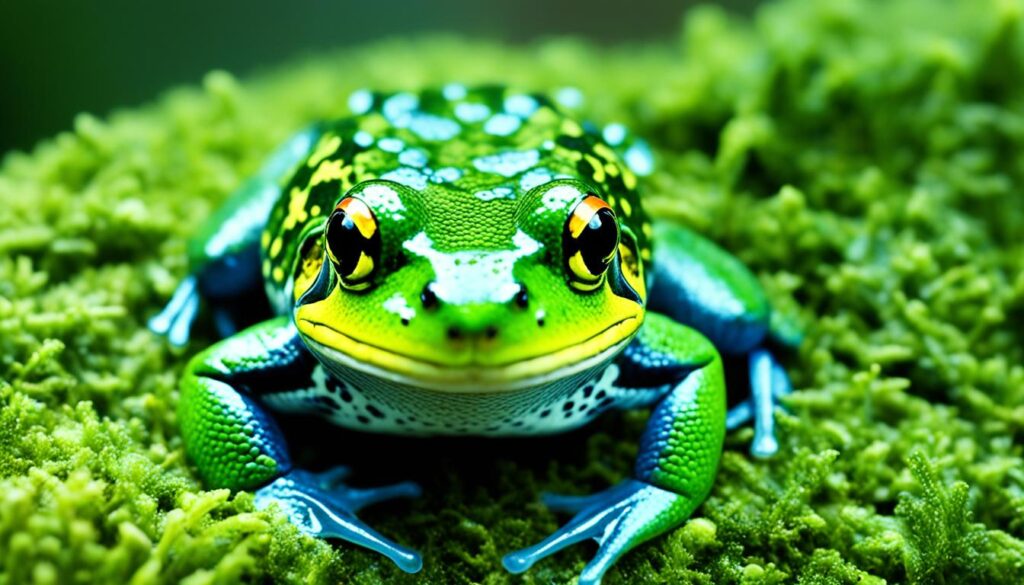
Amphibians have truly remarkable adaptations that enable them to thrive in different habitats and undergo incredible transformations throughout their life cycle. Their ability to adapt to their environment is a testament to their resilience and survival instincts.
The Evolution and Diversity of Amphibians
Amphibians have a rich evolutionary history and boast a remarkable diversity that spans millions of years. From their emergence and diversification from fish, amphibians have evolved into various orders and families, each with its unique characteristics and examples. These extraordinary creatures also play a crucial role in maintaining the balance of ecosystems.
Evolutionary History of Amphibians
The evolutionary history of amphibians dates back to hundreds of millions of years ago when they first emerged from fish as the first vertebrates to colonize the land. This significant event marked a crucial transitional phase in the history of life on Earth.
Amphibians, with their unique adaptations, pioneered life outside of water, paving the way for the development of reptiles, birds, and mammals. Their ability to live in both aquatic and terrestrial environments played a crucial role in shaping the evolutionary paths of other life forms.
Different Orders and Families of Amphibians
The diversity of amphibians is evident in the various orders and families they belong to. These taxonomic classifications provide insight into their evolutionary relationships and highlight their distinct traits.
Some of the major orders of amphibians include Anura, which includes frogs and toads, Apoda, consisting of caecilians, and Urodela, which encompasses salamanders and newts. Each order possesses unique characteristics and adaptations that have allowed them to thrive in specific habitats and environments.

The Role of Amphibians in Ecosystems
Amphibians play a vital role in maintaining the balance of ecosystems. As both predators and prey, they contribute to the regulation of populations within their habitats. Their carnivorous appetite helps control insect populations, preventing outbreaks that could disrupt the ecosystem.
Amphibians also serve as indicators of environmental health. Their sensitivity to changes in habitat and water quality makes them valuable indicators of ecosystem quality. Declines in amphibian populations can signal environmental issues, such as pollution or habitat destruction, alerting conservationists to take action.
Furthermore, amphibians play a crucial role in nutrient cycling. They feed on both aquatic and terrestrial organisms, redistributing nutrients across ecosystems. This process helps support the growth of plants and other organisms, ensuring the overall health and productivity of their habitats.
In conclusion, the evolution and diversity of amphibians are awe-inspiring. From their ancient origins to their diverse taxonomic groups, these creatures continue to fascinate researchers and conservationists alike. Understanding their evolutionary history, different orders, and families provides valuable insights into their adaptations and ecological significance. By appreciating and protecting these remarkable animals, we can help maintain the delicate balance of ecosystems and preserve their diversity for future generations.
Conclusion
Throughout this article, we have explored the fascinating world of amphibians and their incredible adaptations. From their unique characteristics to their distinct life cycles, we have come to understand the remarkable nature of these creatures. Amphibians are true masters of adaptation, with their ability to thrive in both land and water environments, their cold-blooded nature, and their moist and permeable skin. Their primitive lungs and three-chambered heart make them truly unique among vertebrates.
One of the most fascinating aspects of amphibians is their reliance on water for reproduction and the incredible process of metamorphosis. From fertilizing their eggs externally to growing four legs as adults, amphibians undergo incredible transformations during their life cycle. Their carnivorous appetite and status as vertebrates further highlight their distinct characteristics.
As we continue to learn more about amphibians, we also face the conservation challenges they encounter. Habitat loss, climate change, pollution, and disease pose significant threats to these remarkable creatures. It is essential that we recognize the importance of protecting amphibians and their habitats, as they play a crucial role in maintaining the balance of ecosystems.
In conclusion, amphibians are truly extraordinary creatures. From their unique adaptations to their diverse life cycles, they captivate our imagination and inspire us to protect their existence. By raising awareness and supporting conservation efforts, we can ensure that future generations will continue to appreciate the beauty and significance of these masters of adaptation.
